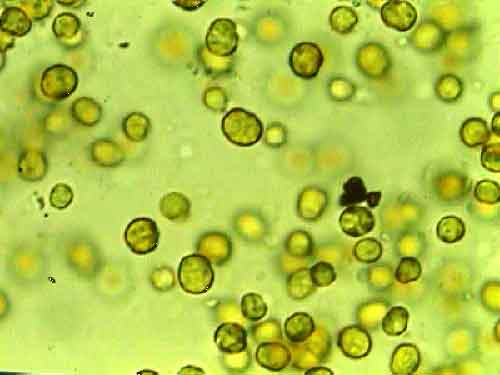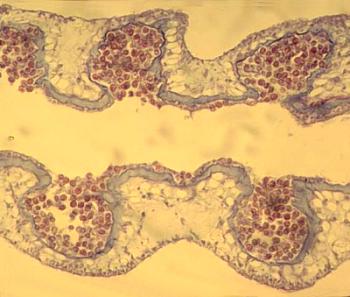Zooxanthellae
|
NCBI: |
This is a test!

Classification
Higher order taxa
Eukaryota; Alveolata; Dinophyceae
Species:
Symbiodinium microadriaticum
Symbiodinium californium
Symbiodinium mustcatinei
Description and Significance
Zooxanthellae species are members of the phylum Dinoflagellata. However, this is not a taxonomic name. Instead, it refers to a variety of species that form symbiotic relationships with other marine organisms, particularly coral. The most common genus is Symbiodinium. Not all Zooxanthellae are endosymbionts; some are free-living. Typically, Zooxanthellae form relationships with organisms simply because they inhabit the same area. However, there are other ways for organisms to acquire Zooanthellae endosymbionts. In the sea anenome Anthopleura ballii, Zooxanthellae are inherited maternally. This, however, is a rare phenomenon.
Genome Structure
There is not yet an extensive body of research on the numerous genome structures within the Zooxanthellae category.
Cell Structure and Metabolism

Zooxanthellae are unicellular organisms with a spherical shape. They have two flagella, although these are lost if the organism is acquired by a host. This is called the coccoid state.
Zooxanthellae are mixotrophic organisms. They are mainly photosynthetic organisms (photoautotrophic). However, some species can also obtain food by ingesting other organisms.
Asexual reproduction by division is the most common form of reproduction. Zooxanthellae typically spend their entire life on the organism to which they are attached. The exception is when coral bleaching occurs, and the Zooxanthellae are expelled from the coral.
Ecology
Zooxanthellae are known for their symbiotic relationships with
coral. Zooxanthellae often suffer from bacterial infections that attack
corals. For example, the bacteria that causes Yellow Band/Blotch
Disease (YBD) in Montastraea species actually affects the
Zooxanthellae endosymbionts rather than the actual organism. Many
bacterium interfere with the photosynthetic processes of these
organisms. Zooxanthellae can help host coral harvest light. This helps
the host meet its carbon and energy needs. In addition, Zooxanthellae
give host corals their color. The research of Levy et. al. (2003)
indicates that corals with continuously extended tentacles have denser
populations of Zooxanthellae. Coral bleachings are caused by a
disruption in these relationships. Symbiotic relationships with corals
and other organisms are common in tropical waters with a low abundance
of nutrients. These relationships are significantly less common in
temperate waters.
The Adaptive Bleaching Hypothesis (ABH) suggests that if the loss of Zooxanthellae
occurs due to environmental change, the host organism forms a new
symbiotic relationship with a different type of Zooxanthellae. These
new endosymbionts are blelieved to be better adapted to the new
environment. Other research on the adaptations of coral and
Zooxanthellae suggest that corals that have been damaged due to high
temperatures contain an abundance of Zooxanthellae that are thermally
tolerant (Baker et. al. 2004). The symbiont changes during the stress
period. It is suggested that these corals will be resistant to future
thermal stress because they now have an endosymbiont that will better
help them manage these environmental conditions. Rowan (2004) also
shows that corals adapt to high temperatures by hosting Zooxanthellae
that are specifically adapted to such conditions.
In addition to living in coral, Zooxanthellae can inhabit clams,
nudibranches, flatworms, octocorals, sea anenomes, hydrocorals,
mollusks, zoanthids, sponges, Foraminifera, and jellyfish.

References
Heatherwick, Pete and Sue Heatherwick. "Guide to the Great Barrier Reef." Accessed 5 July 2005.
Ho, Leonard. "Zooxanthellae." March 8, 1998. Accessed 5 July 2005.
Rowan, Rob. "Thermal adaptation in reef coral symbionts." Nature. 12 August 2004;430:742.
Sea World/Busch Gardens Animal Information Database. Accessed 5 July 2005.
